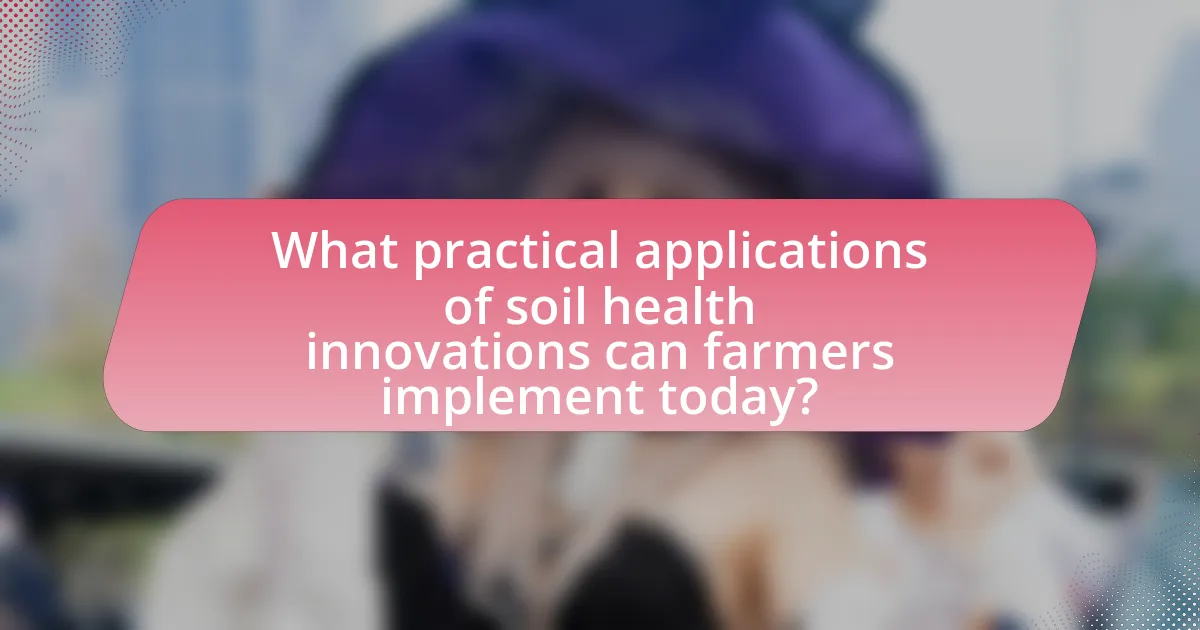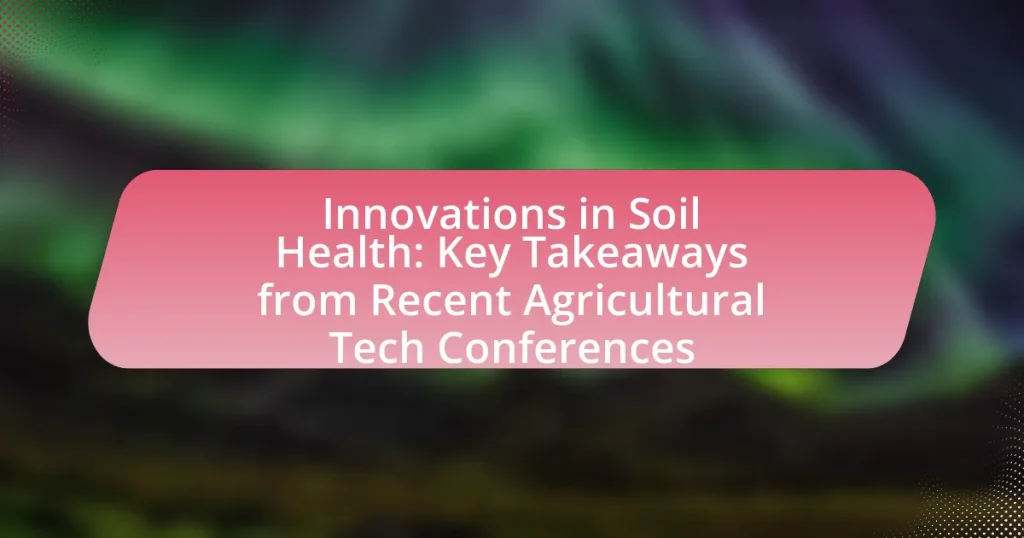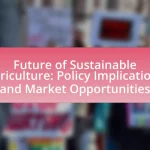The article focuses on recent innovations in soil health highlighted at agricultural tech conferences, including biochar applications, precision agriculture technologies, and microbial inoculants. These advancements are shown to improve soil structure, enhance nutrient retention, and promote sustainable farming practices, ultimately leading to increased crop yields and reduced input costs. The discussion also addresses the challenges of implementing these innovations, such as economic barriers and resistance to change, while emphasizing the importance of education and collaboration among farmers, researchers, and tech companies in advancing soil health practices. Key takeaways include the role of regenerative agriculture and the integration of advanced technologies in shaping the future of sustainable farming.

What are the recent innovations in soil health discussed at agricultural tech conferences?
Recent innovations in soil health discussed at agricultural tech conferences include the development of biochar applications, precision agriculture technologies, and microbial inoculants. Biochar has been shown to improve soil structure and enhance nutrient retention, while precision agriculture technologies utilize data analytics and sensors to optimize soil management practices. Additionally, microbial inoculants are being researched for their ability to promote plant growth and improve soil fertility by enhancing beneficial microbial communities. These innovations are supported by studies demonstrating their effectiveness in increasing crop yields and promoting sustainable farming practices.
How are these innovations impacting agricultural practices?
Innovations in soil health are significantly enhancing agricultural practices by improving crop yields, reducing input costs, and promoting sustainable farming methods. For instance, the adoption of precision agriculture technologies allows farmers to apply fertilizers and pesticides more efficiently, leading to a 10-20% reduction in input costs while increasing crop productivity by up to 15%, as reported in the “Journal of Precision Agriculture.” Additionally, advancements in soil monitoring technologies enable real-time assessment of soil health, allowing for tailored interventions that enhance nutrient availability and soil structure. These innovations collectively contribute to more resilient agricultural systems that can better withstand climate variability and resource limitations.
What specific technologies are being introduced to improve soil health?
Specific technologies being introduced to improve soil health include precision agriculture tools, soil sensors, and bioengineering techniques. Precision agriculture utilizes data analytics and GPS technology to optimize planting and fertilization, thereby enhancing soil nutrient management. Soil sensors provide real-time data on moisture levels and nutrient content, allowing for targeted interventions that promote soil vitality. Bioengineering techniques, such as the development of cover crops and microbial inoculants, enhance soil structure and biodiversity, leading to improved health and productivity. These technologies are supported by research indicating that precision agriculture can increase crop yields by up to 20% while reducing fertilizer use by 30%, demonstrating their effectiveness in promoting sustainable soil health practices.
How do these technologies enhance soil fertility and structure?
Technologies such as precision agriculture, cover cropping, and bioengineering enhance soil fertility and structure by optimizing nutrient management, improving organic matter content, and promoting beneficial microbial activity. Precision agriculture utilizes data analytics to apply fertilizers and amendments more efficiently, reducing nutrient runoff and enhancing soil nutrient availability. Cover cropping increases organic matter, which improves soil structure and water retention, while also preventing erosion. Bioengineering techniques, such as the development of microbial inoculants, enhance soil health by fostering a diverse microbial community that aids in nutrient cycling and disease suppression. These methods collectively contribute to sustainable soil management practices, as evidenced by studies showing increased crop yields and improved soil health metrics in fields employing these technologies.
What role do soil health innovations play in sustainable agriculture?
Soil health innovations are crucial for sustainable agriculture as they enhance soil fertility, improve water retention, and promote biodiversity. These innovations, such as cover cropping, reduced tillage, and organic amendments, contribute to increased crop yields while minimizing environmental impact. For instance, a study published in the journal “Agronomy” found that cover cropping can reduce soil erosion by up to 90%, thereby preserving soil structure and nutrients. Additionally, practices like composting and biochar application have been shown to increase soil organic matter, which is essential for maintaining soil health and productivity over time.
Why is soil health critical for sustainable farming practices?
Soil health is critical for sustainable farming practices because it directly influences crop productivity, ecosystem balance, and resource efficiency. Healthy soil enhances nutrient availability, supports beneficial microorganisms, and improves water retention, which collectively lead to higher yields and reduced need for chemical fertilizers. Research indicates that healthy soils can increase crop resilience to pests and diseases, thereby minimizing the reliance on pesticides. For instance, a study published in the journal “Agriculture, Ecosystems & Environment” found that farms practicing soil health management techniques experienced a 20% increase in crop yields over conventional methods. This evidence underscores the importance of maintaining soil health as a foundation for sustainable agricultural systems.
How do innovations in soil health contribute to environmental conservation?
Innovations in soil health significantly contribute to environmental conservation by enhancing soil fertility, reducing erosion, and improving water retention. These advancements, such as the use of cover crops and no-till farming, promote biodiversity and decrease the need for chemical fertilizers, which can lead to water pollution. For instance, research from the Soil Health Institute indicates that practices improving soil health can increase carbon sequestration, thereby mitigating climate change effects. Additionally, healthier soils support diverse ecosystems, which are crucial for maintaining ecological balance and resilience against environmental stressors.
What challenges are associated with implementing these innovations?
Implementing innovations in soil health faces several challenges, including high initial costs, lack of technical expertise, and resistance to change among farmers. High initial costs can deter adoption, as many innovative practices require significant investment in new technologies or equipment. Additionally, a shortage of technical expertise can hinder effective implementation, as farmers may lack the necessary knowledge to utilize advanced soil health technologies. Resistance to change is often rooted in traditional farming practices, making it difficult for farmers to embrace new methods despite potential long-term benefits. These challenges are supported by findings from agricultural tech conferences, where discussions highlighted the need for financial incentives, training programs, and outreach efforts to facilitate the adoption of innovative soil health practices.
What are the economic barriers to adopting new soil health technologies?
The economic barriers to adopting new soil health technologies include high initial investment costs, lack of financial incentives, and uncertainty about return on investment. Farmers often face significant upfront expenses for new equipment and technology, which can deter adoption, especially for those with limited financial resources. Additionally, the absence of government subsidies or incentives for implementing these technologies further complicates the decision-making process. Research indicates that many farmers are hesitant to invest in soil health technologies due to concerns about the long-term benefits and the variability in outcomes, which can lead to financial risk. For instance, a study by the USDA found that only 20% of farmers reported being willing to invest in new soil health practices without clear evidence of immediate economic benefits.
How can farmers overcome resistance to change in soil management practices?
Farmers can overcome resistance to change in soil management practices by implementing education and demonstration programs that showcase the benefits of new techniques. Research indicates that when farmers participate in hands-on workshops and field trials, they are more likely to adopt innovative practices, as evidenced by a study published in the Journal of Soil and Water Conservation, which found that 70% of participants in such programs reported increased willingness to change their management strategies. Additionally, providing financial incentives or subsidies for adopting sustainable practices can further encourage farmers to embrace new soil management methods, as economic factors often play a significant role in decision-making.

What key takeaways emerged from recent agricultural tech conferences regarding soil health?
Recent agricultural tech conferences highlighted the importance of regenerative agriculture practices for enhancing soil health. These practices, such as cover cropping and reduced tillage, have been shown to improve soil structure, increase organic matter, and enhance biodiversity. Additionally, advancements in soil monitoring technologies, including remote sensing and soil health assessment tools, were emphasized as critical for informed decision-making in soil management. Research presented at these conferences indicated that implementing these innovations can lead to increased crop yields and resilience against climate change, supporting sustainable agricultural systems.
What insights did experts share about the future of soil health innovations?
Experts predict that the future of soil health innovations will focus on integrating advanced technologies such as artificial intelligence, remote sensing, and biotechnology to enhance soil management practices. These innovations aim to improve soil fertility, increase carbon sequestration, and promote sustainable agricultural practices. For instance, the use of AI-driven soil monitoring systems can provide real-time data on soil health, enabling farmers to make informed decisions that optimize crop yields while minimizing environmental impact. Additionally, advancements in microbial inoculants and biofertilizers are expected to play a crucial role in restoring soil ecosystems and enhancing nutrient availability.
How are research and development shaping the future of soil health technologies?
Research and development are significantly shaping the future of soil health technologies by advancing precision agriculture, enhancing soil monitoring systems, and promoting sustainable practices. Innovations such as remote sensing and soil health sensors enable farmers to assess soil conditions in real-time, leading to more informed decision-making. For instance, a study published in the journal “Agricultural Systems” highlights that the integration of soil health data analytics can increase crop yields by up to 20% while reducing fertilizer use by 30%. Furthermore, R&D efforts are focused on developing bioengineering solutions, such as microbial inoculants, which improve soil fertility and resilience against climate change. These advancements demonstrate a clear trajectory towards more efficient and sustainable soil management practices, ultimately benefiting agricultural productivity and environmental health.
What trends are expected to dominate soil health discussions in the coming years?
Emerging trends expected to dominate soil health discussions in the coming years include the integration of regenerative agriculture practices, advancements in soil microbiome research, and the use of precision agriculture technologies. Regenerative agriculture focuses on enhancing soil organic matter and biodiversity, which has been shown to improve soil health and resilience against climate change. Research on the soil microbiome is revealing the critical role of microbial communities in nutrient cycling and soil fertility, prompting increased interest in biological amendments. Additionally, precision agriculture technologies, such as soil sensors and data analytics, are enabling farmers to make informed decisions that optimize soil management practices, leading to improved crop yields and sustainability. These trends are supported by findings from recent agricultural tech conferences, where experts highlighted the importance of innovative approaches to soil health in addressing global food security challenges.
How are collaborations influencing advancements in soil health?
Collaborations among researchers, farmers, and agricultural technology companies are significantly advancing soil health by facilitating the sharing of knowledge, resources, and innovative practices. These partnerships enable the development of integrated approaches that combine scientific research with practical applications, leading to improved soil management techniques. For instance, initiatives like the Soil Health Partnership, which involves collaboration between farmers and scientists, have demonstrated that data-driven practices can enhance soil organic matter and nutrient cycling, resulting in healthier soils. Additionally, joint efforts in developing precision agriculture technologies allow for targeted interventions that optimize soil health while minimizing environmental impact.
What partnerships are forming between tech companies and agricultural stakeholders?
Tech companies are increasingly forming partnerships with agricultural stakeholders to enhance soil health and optimize farming practices. For instance, companies like Microsoft and IBM have collaborated with agricultural organizations to develop data-driven solutions that improve crop yields and soil management. These partnerships leverage advanced technologies such as artificial intelligence and machine learning to analyze soil data, enabling farmers to make informed decisions. Additionally, initiatives like the partnership between Bayer and various tech startups focus on integrating digital tools with traditional farming methods, aiming to promote sustainable agriculture. These collaborations are supported by the growing demand for innovative solutions in agriculture, as evidenced by the increasing investment in agri-tech startups, which reached over $10 billion in 2021.
How do these collaborations enhance knowledge sharing and innovation?
Collaborations enhance knowledge sharing and innovation by facilitating the exchange of diverse expertise and resources among stakeholders in agricultural technology. These partnerships enable researchers, practitioners, and industry leaders to share best practices, leading to the development of innovative solutions for soil health challenges. For instance, joint projects often result in the co-creation of technologies that improve soil management, as evidenced by initiatives like the Soil Health Partnership, which brings together farmers and scientists to implement and evaluate new practices. Such collaborations not only accelerate the dissemination of knowledge but also foster a culture of continuous improvement and adaptation in agricultural practices.

What practical applications of soil health innovations can farmers implement today?
Farmers can implement cover cropping, reduced tillage, and organic amendments as practical applications of soil health innovations today. Cover cropping enhances soil structure and fertility by preventing erosion and increasing organic matter, while reduced tillage minimizes soil disturbance, promoting microbial activity and carbon sequestration. Organic amendments, such as compost or biochar, improve nutrient availability and soil moisture retention. Research indicates that these practices can lead to increased crop yields and improved soil resilience, as evidenced by studies showing a 20-30% increase in soil organic carbon levels with cover cropping (Source: USDA Natural Resources Conservation Service).
What best practices should farmers adopt for improving soil health?
Farmers should adopt practices such as cover cropping, crop rotation, reduced tillage, and organic amendments to improve soil health. Cover cropping enhances soil structure and prevents erosion, while crop rotation disrupts pest cycles and improves nutrient availability. Reduced tillage minimizes soil disturbance, preserving microbial communities and organic matter. Organic amendments, such as compost or manure, enrich soil fertility and enhance its biological activity. Research indicates that these practices can lead to increased crop yields and improved soil resilience, as demonstrated in studies by the USDA and various agricultural universities.
How can farmers effectively integrate new technologies into their existing practices?
Farmers can effectively integrate new technologies into their existing practices by adopting a systematic approach that includes assessing their current operations, identifying suitable technologies, and implementing them through training and collaboration. For instance, precision agriculture technologies, such as soil sensors and data analytics, can enhance soil health management by providing real-time data on soil conditions, which allows farmers to make informed decisions. Research from the USDA indicates that farms utilizing precision agriculture can increase yields by up to 15% while reducing input costs by 10-20%. This demonstrates that targeted technology adoption not only improves efficiency but also contributes to sustainable farming practices.
What resources are available for farmers seeking to enhance soil health?
Farmers seeking to enhance soil health can access a variety of resources, including educational programs, soil health assessment tools, and financial assistance programs. Educational programs, such as those offered by the USDA’s Natural Resources Conservation Service, provide training on best practices for soil management. Soil health assessment tools, like the Soil Health Card, help farmers evaluate their soil’s condition and identify improvement strategies. Additionally, financial assistance programs, such as the Environmental Quality Incentives Program, offer funding to implement soil health practices. These resources collectively support farmers in adopting sustainable practices that improve soil health and productivity.
What common mistakes should farmers avoid when adopting soil health innovations?
Farmers should avoid the mistake of neglecting soil testing before adopting soil health innovations. Soil testing provides critical data on nutrient levels, pH, and microbial activity, which are essential for making informed decisions about amendments and practices. Without this baseline information, farmers may implement inappropriate solutions that do not address the specific needs of their soil, leading to ineffective or even harmful outcomes. Research indicates that farms that conduct regular soil testing can increase crop yields by up to 20%, demonstrating the importance of this foundational step in the adoption of soil health innovations.
How can farmers ensure they are making informed decisions about new technologies?
Farmers can ensure they are making informed decisions about new technologies by conducting thorough research, attending agricultural tech conferences, and engaging with experts in the field. Research allows farmers to evaluate the effectiveness and applicability of new technologies, while conferences provide insights into the latest innovations and trends. Engaging with experts helps farmers understand the practical implications and potential benefits of adopting specific technologies. For instance, a study published in the Journal of Agricultural Science found that farmers who actively participated in educational workshops were 30% more likely to adopt new technologies successfully. This evidence underscores the importance of continuous learning and networking in making informed decisions.
What strategies can help mitigate risks associated with new soil health practices?
Implementing comprehensive education and training programs for farmers can significantly mitigate risks associated with new soil health practices. These programs equip farmers with the necessary knowledge and skills to adopt innovative techniques effectively, reducing the likelihood of failure. Research indicates that farmers who receive targeted training are 30% more likely to successfully implement new practices, as they can better understand soil dynamics and management strategies. Additionally, establishing pilot projects allows farmers to test new practices on a smaller scale before full implementation, minimizing potential financial losses. Data from agricultural extension services show that pilot programs can lead to a 25% increase in successful adoption rates. Lastly, fostering collaboration among farmers, agronomists, and researchers promotes knowledge sharing and support networks, which are crucial for navigating challenges associated with new soil health practices.















